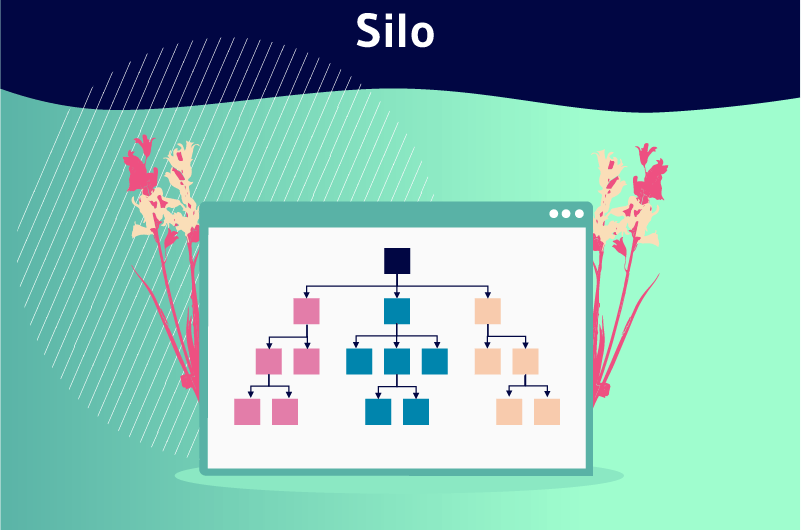The Silo concept refers to SEO a form of organization of content that consists of grouping the pages of a website by theme. The idea is to form blocks of pages linked together around a universe of related keywords. The silo is used in SEO to optimize the internal linkage system set up on a site and lead visitors to discover other interesting pages related to their initial search theme
You need to have enough time and energy to set up an SEO strategy on a site. Especially with Google’s multiple requirements, you have to work hard to produce quality content followed by good optimization to hope to achieve a good ranking on Google.
However, if you don’t use a great site architecture, human visitors and crawlers may have difficulty discovering the full extent of the content you produce. This brings us to the concept of “Silo”
- What is a silo architecture?
- And how does it contribute to the good referencing of a website on Google?
Let’s find out together
Chapter 1: What does the term Silo mean and why is it useful in SEO?
A silo structure is a good site architecture that allows you to group the contents of your site in such a way that robots and visitors will have easier access. Find out more about this in this chapter.
1.1) What is the Silo structure in SEO?
A silo is a compartment of your site dedicated to a specific theme or more precisely to a keyword. Depending on the structure, each silo may contain a main page dedicated to a specific keyword.
The different sub-pages that make up the whole silo will each target a secondary expression to support the main term. Thus, your site will have level 2, 3, 4 … content, whose main terms relate to the main keyword on which the site is positioned.
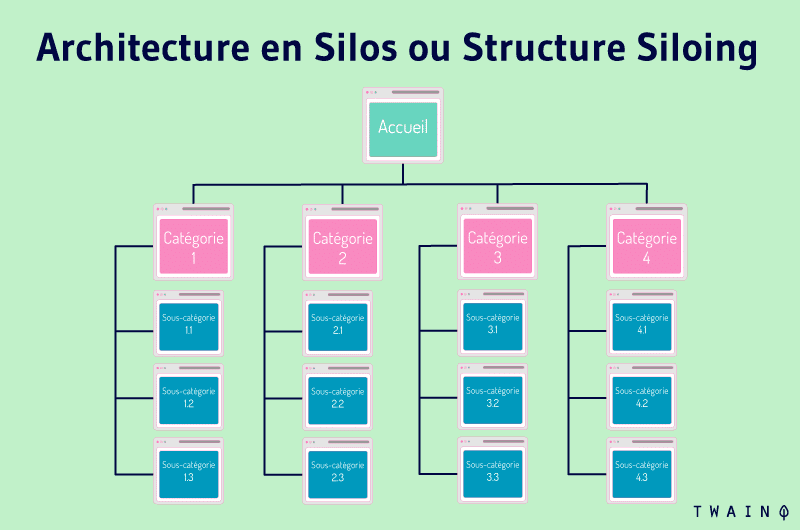
The number of levels is not limited and varies according to your sector of activity. Moreover, each content classified at a lower level reinforces the level directly above it through different links woven between the pages of the same silo.
Depending on the case, we can find several levels:
- Semantic links: The content reinforces the relevance of the upper pages of the section by using expressions from the same semantic universe. This can be synonyms, frequently used terms, acronyms, etc.
- Thematic links: These are links that point to another silo. However, links between different silos must leave the lower level of the first silo to the first level of the second silo.
However, it is important not to confuse the SEO silo with the marketing silo. The first is considered a factor of natural referencing while the second is to be avoided. In fact, the marketing silo refers to a breakdown in collaboration between the different marketing functions of the same company.
1.2) Why are silos important for SEO?
The silo structure is used in SEO to improve the user experience and to make it easier for search engine robots to crawl. Silos make your site’s architecture fluid and also improve the organization of its content.

By organizing your content in this way, you will make your visitors want to spend more time on your site and browse several web pages. Moreover, visitors will no longer be exposed to endless searches.
They will be able to quickly understand the organization principle of the page they are on and even find the information just in time. In fact, the silo structure allows visitors to stop getting lost.

They can make several choices on your site such as following internal links within the silo or visiting other pages outside the silo without having an embarrassment of choice. The organization of your site structure in silo offers multiple advantages on the SEO plan.
This organizational technique allows you to strengthen the natural referencing through :
- The improvement of the ergonomics and the structure of the site;
- A good positioning on competitive keywords;
- A good sharing of link juice between web pages;
- The increase of web traffic;
- A better ranking in the SERPs.
1.2.1. Optimization of the ergonomics and structure of the website
The content silos are mainly useful to make the tree structure of your site more optimal. Indeed, this technique of content silos allows you to reorganize and optimize the architecture of the site in general.
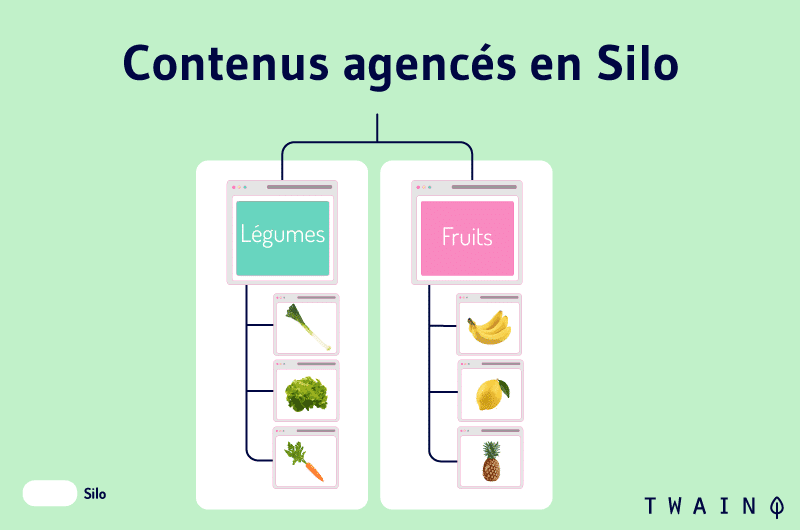
The silos allow you to create a more ergonomic tree structure. In terms of SEO, the layout of a more fluid and optimal site structure with a transparent semantic field makes it easier for crawlers to find your site. Your site would therefore be likely to gain a better ranking in the search results.
1.2.2. A good positioning on competitive keywords
After the optimization of the tree structure of the contents of your website, the silos also allow you to position your web pages on keywords of very competitive queries
Indeed, when you build a silo organization around a specific keyword on a main page, the other pages that form the silo cover the other aspects of this same keyword.

As a result, all the pages that make up the silo are each positioned on a key term that links directly to the main keyword. With this structure, the pages of your site will be more likely to be ranked in the SERPs for specific queries.
1.2.3. Benefit from a good link juice sharing between web pages
In SEO, the term link juice is the total benefits of links from one page to another. It is also called PageRank.
A siloed content organization is beneficial for your web pages because it allows an equitable distribution of link juice.
Building silos improves internal site meshing by generating optimal links between content of the same level and between different categories of silos on the site. This structure improves the sharing of SEO link juice between the different pages making up the silo.
1.2.4. A better ranking in the SERPs.
SEO silos are also a factor in developing visibility on search engines. First, silos make it easier for crawlers to crawl your site by creating a more ergonomic tree structure.
Crawlers better understand the structure of the site, which can be a proof of credibility with Google. The fluidity of traffic on a website allows crawlers to save the crawl budget, establish links between different web pages and better index the content.

On the other hand, the use of semantic silos can help to quickly position your pages. Semantic silos require a high quality of writing for each theme developed.
However, Google’s algorithms love qualitative content and may conclude that your site has merit. The more qualitative your web pages are, the more your chance of ranking in the Google SERPs increases.
Finally, you will have a good visibility on search engines by opting for SEO silos.
1.2.5. Increasing web traffic
With the SEO silo technique, your site has a great chance of appearing among the top search results on Google even for highly competitive queries.
Since content silos allow you to better exploit long tail keywords, many of your web pages will be positioned on specific keywords. Therefore, you can benefit from quality web traffic.
1.3. The different types of SEO silos
Speaking of the silo organization of the contents of a website, there are mainly two types of silos: the thematic silo and the semantic silo. At first glance, these two techniques may seem similar. But in reality, they are two very different techniques, even if they complement each other.
1.3.1. The thematic silo
The thematic silo is a content prioritization technique based mainly on the user experience. This method places visitors at the heart of the actions.
It is the most widely used technique on the web and consists of structuring the content of the site in such a way as to build a logical and intuitive architecture. This fluid architecture improves navigation between different web pages.
The thematic silo is more used on online stores and e-commerce sites. E-merchants use it to organize each product in its specific category while taking into account its use and characteristics.
1.3.2. The semantic silo
The structure of the semantic silo employs much the same principle as the semantic cocoon. By definition, the semantic cocoon is a method used by SEO experts to link the tree structure to the internal mesh.
This technique actually allows to associate the pages of a website that deal with the same theme. The semantic cocoon is based on the semantic analysis of relevant keywords.
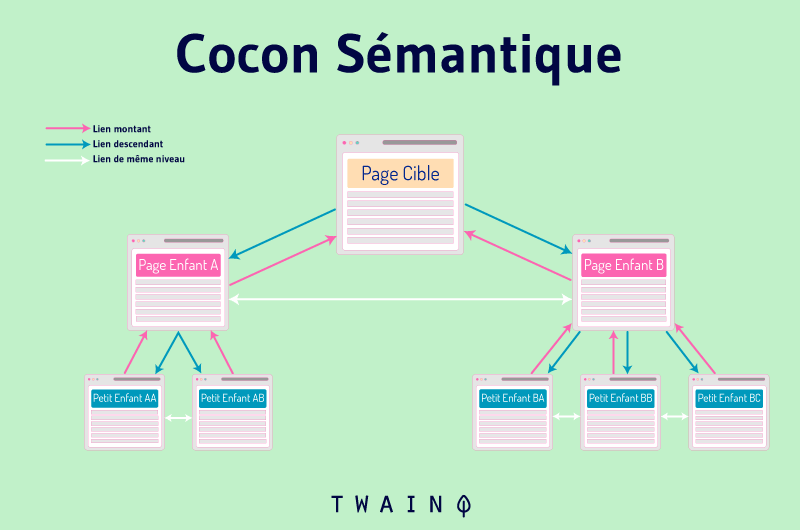
Similarly, the practice of semantic silo consists of reorganizing the structure of a site based on the semantic universe of keywords of each page of the site. The advantage of the semantic silo is that it allows you to obtain a well optimized tree structure based on semantics to facilitate the exploration of robots.
The semantic silo takes into account the understanding of the algorithm for a ranking objective in the SERPs.
1.4. When should a silo structure be implemented?
If you are considering implementing an SEO silo on your site to organize your content for better Google ranking, know that it is never too late to do so
However, the ideal time to adopt such a strategy usually depends on your site’s situation.
You may decide to adopt a silo structure:
- After exhausting a Google penalty;
- When redesigning your site;
- From the creation of your site, etc.
1.4.1. Adopting a silo structure after suffering a Google penalty
The first thing to do when your site has been hit by an algorithmic penalty or a manual action is the site audit. Then comes the correction and remediation stage.

During this process, you may decide to reorganize the content of your site by adopting a silo structure. A silo structure at this time will help you convince Google and easily regain its trust.
Once you get out of the penalty, your site can also quickly regain its notoriety and move up in the search results.
1.4.2. Adopt a silo structure when creating your site
This is the simplest and most effective method. It consists in defining the silo structure as an action plan for your site as soon as it is online.
Your site will therefore benefit from an optimal tree structure as soon as it goes online. It is a better technique to get a growing visibility on the web and to stand out from the competition. With a silo structure, your site will benefit from a great SEO performance and a good positioning from the start.
1.4.3. Adopt a silo structure when redesigning your site
Even if your site is already online, it is still possible to define a silo structure for your content. However, the best way to integrate this new configuration is to take advantage of a redesign operation.

The SEO silo would be a real complement to the different configurations operated on the site during the redesign. One more silo structure will boost your site’s SEO as soon as it goes live.
Chapter 2: How to set up a silo structure?
If you already know what a siloed tree structure means and the best times to adopt such an organization on your site, what are you waiting for to take action? Well, it’s also important to know how to proceed to get better results at the end of the job.
Because to say the least, setting up a siloed tree structure is a long and tedious job. This task can become more complex depending on the number of pages to reorganize around the main keyword.
To structure the pages of your site in silo, you will have to follow several steps including
- Define your site and create your customer avatar;
- Do a keyword audit;
- Define a keyword strategy;
- Organize the main keywords by theme;
- Define the different levels of your silo;
- Write your articles;
- Make the internal link of the different elements of each level of silo.
2.1. Do the keyword audit
The first task to accomplish when you want to set up a silo structure is to do a keyword audit. This involves analyzing the semantic universe of your web activity domain through the keywords.
This audit must allow you to distinguish your different keywords. You must be able to assign a degree of importance to each of them. The objective is to be able to classify the requests from the most important to the least important:
- The main queries ;
- Secondary queries;
- Long tail queries.
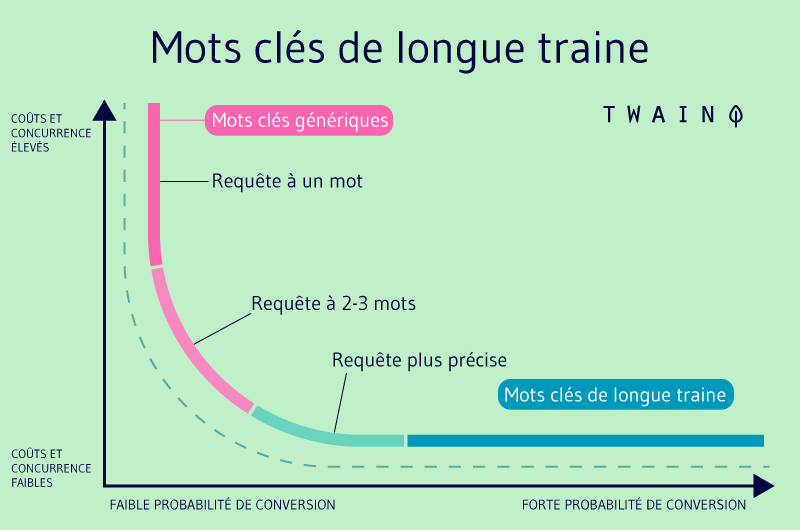
This work will teach you more about your target’s needs, their query terms and semantic shifts. You must therefore make a list of keywords according to themes, priority and type of need in order to better break down your semantic universe and the lexical field of words to target.
The keyword audit will also consist in listing the competitors, especially those who are well positioned on the same theme as you. To analyze the semantic universe of your competitors’ sites, you can use an SEO tool like SEMrush, or Google Keyword Planner, available in the Google Ads interface. There are other tools that can give other leads to evaluate the lexical fields of the keywords to target.
These are:
- Answers the question ;
- 1.en ;
- SEO Hero, etc.
When you use several tools when researching and analyzing keywords, you have the advantage of exploring all possible parameters to draw all the data and export it. With Google Keyword Planner, you can look at the number of monthly searches that are on each of the keywords.
You can also compare the relevance of its keywords to competing sites that are already ranking in the SERPs on its same keywords. However, if you want to get an idea about the complexity of positioning on the found keywords, just look at the search results of the target queries.
The other method is to look at and examine the different pages of the sites that are displayed in the SERP for the target queries. The SEMrush Keyword Difficulty tool also offers estimates on the difficulty of positioning on a relevant keyword. All these combinations of analysis results will give you a clearer idea about the quality of keywords to target as well as the amount of content to gain a more optimal ranking on Google.
2.2. Define the different semantic levels
Depending on your activity and the themes you deal with, you must create content to cover the entire lexical field. Thus, we can find several levels of content:
- Level 1 includes content on the most important topics of the main theme;
- Level 2 contains content that goes into more detail on the important topics of level 1;
- Level 3 contents deepen the topics of level 2 and so on.
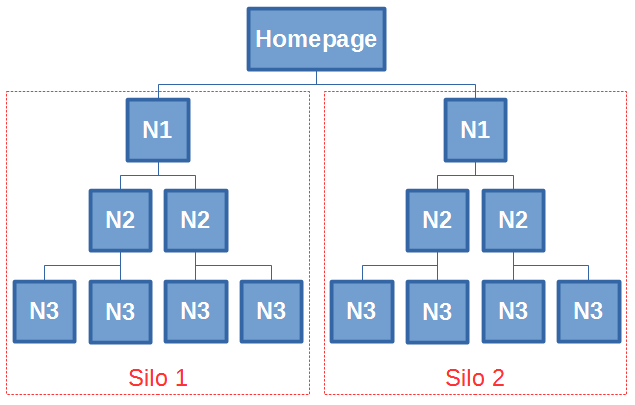
Source: Press Enter
With this procedure, you will produce a lot of content around your main theme. There will be a larger semantic universe around the theme, targeting new specific keywords and the long tail.
However, the number of content levels in the silo structure depends on your sector of activity and also on the theme. We can find dozens of levels by analyzing the silo architecture of the best sites ranked in the first 3 positions of the SERPs for a target query.
Note however that 2 to 3 levels are sufficient for a niche site, although you are free to decide the number of levels. The good news is that there are tools and software that make it easy to install siloing on a website. To set up the different levels of your site’s silo structure, I suggest using Mindmeister mind mapping software.

It is a very practical tool that allows you to arrange your content according to different levels starting from the main theme.
2.3. The actual design of the silo
To achieve this, you need to classify the articles on your site according to the themes. You must link the contents by grouping the articles of the same theme in a specific group.
If you have a site that deals with tourism for example, the articles that deal with the subject of “travel” will be grouped in the same category. The same goes for other topics that are related to the main keyword.
However, you must avoid creating links that cross between the different categories. This internal linkage will allow your visitors to explore several articles on the same subject without getting lost on the site.

On the other hand, if you create links that go in all directions, your site will have a complex mesh and the silo will suffer from semantic confusion. Neither visitors nor search engines will be able to easily find their way around your site.
Search engine spiders will not be able to clearly identify your key themes and all your SEO actions may remain without positive effect. To implement a silo structure, it is therefore important to consider several factors.
If you are used to reading articles on websites, you will often come across recommendations of articles of the same theme at the bottom of the article you are reading. You should do the same on your site.
You should only display articles that deal with the same subject and avoid displaying articles of different themes. It’s the same for rich menus. You must avoid drop-down menu lists that can disturb the silo design and negatively impact the SEO of your site.
2.4. Presentation of the silo structure
Silos are usually grouped together in the menu. In the menu, each silo represents a section that deals with a specific subject related to the main theme of the site.
2.4.1. Using a partitioned silo
As mentioned above, there are different levels in a silo. Considering the example of the keyword “tourism in Africa”, we can find a level 1 page that deals with tourism in general.
Another page of level 2 comes to amortize the level 1 by bringing more details. This page can deal with the different tourist destinations in Africa: Senegal, South Africa, etc.
To support the subject of the level 2 page, you can create level 3 pages that will deal with subjects such as: tourism in Senegal, tourism in South Africa, tourism in Benin, etc. These different pages will bring more details to the level 2 contents and so on.
To optimize internal linking, you can generate links between the different levels of your silo. You can also create links between articles of the same level. However, you should refrain from creating links between articles of different categories.
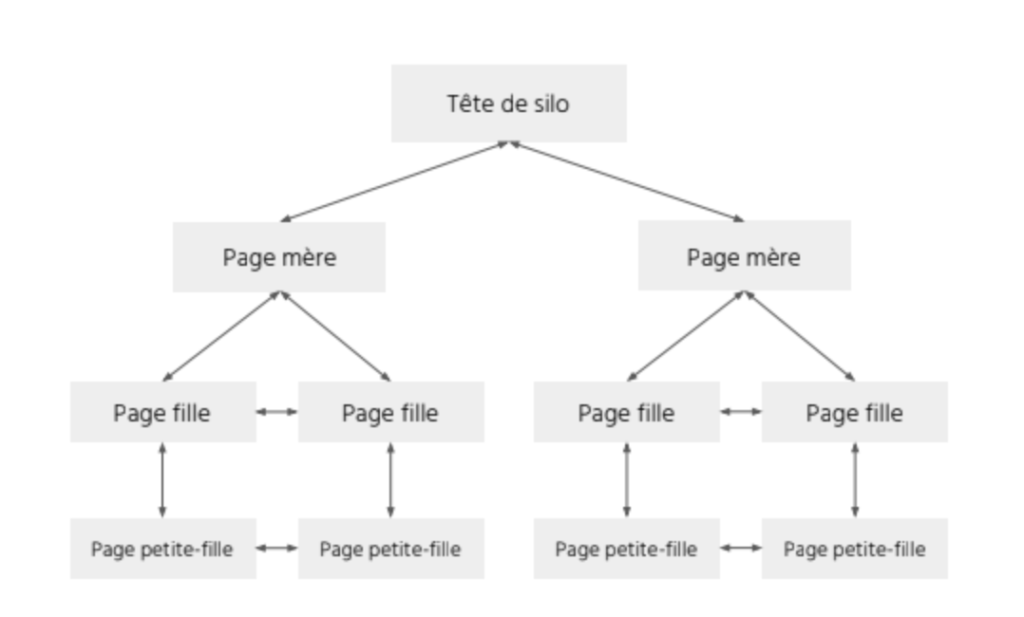
Source: Smart Keyword
To create a link that connects two silos, you must create a level 2 link that directs to the level 1 page of the second silo (which deals with a different topic).
If we consider the same example, you must create a link from the level 2 page that points to a level 1 page (from another silo) that deals with catering.
2.4.2. Optimize internal linking with a landing page
To facilitate access to the content of the level 1 landing page and the level 2 articles, you can define a summary page. This is called a landing page.
It groups either the latest content in the category or a level 2 page that recommends level 2 pages. In the design of the silo, the level 1 page is the most important. It is therefore important to optimize it as much as possible.

You can add texts with strong semantic values. An effective method to boost the authority of the level page is to create an entire page with quality content that showcases the different level 2 pages. With a powerful mesh that links this new page to the level 1 page, you can better reference the level 1 page.
Finally, after designing the silo structure and making the internal mesh of the site, you may decide to visualize and experiment with it before going live. You can do this with the Cocon.se tool.
Summary
The silo structure is an SEO strategy that takes into account the organization of the site’s content and the internal mesh. This strategy allows to improve the navigation on your site and to increase your chances of ranking in Google SERPs.
Of course, there are many techniques to implement a silo structure on a website. Some of these strategies are presented in this article along with the different ways of setting up the internal mesh.
I hope you found this content useful. Feel free to put your opinion in comments
Thanks and see you soon!

